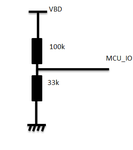zhengchao201105
Member level 2

if VBD is 16v,the mcu IO will get a 16v*33k/(33k+100k)=3.96v,this is a good value for a 5v powered MCU
but if change VBD to 26v,the mcu IO will get a 26v*33k/(33k+100k)=6.45V,in this case,does the mcu can still get a 5v input(the mcu will think the external power is 5v/33k*(100k+33k)=20.1V)?or the mcu IO will get a low level even damaged?

